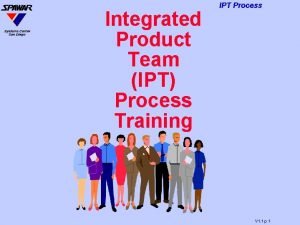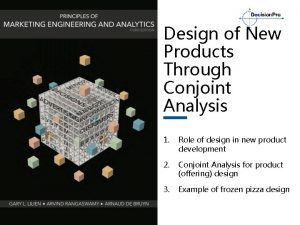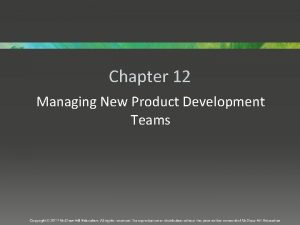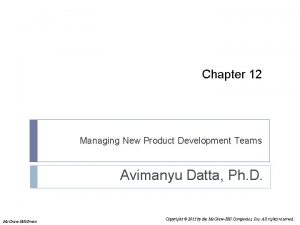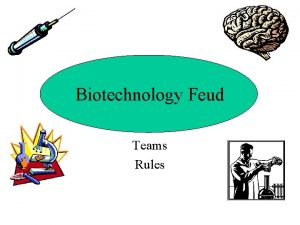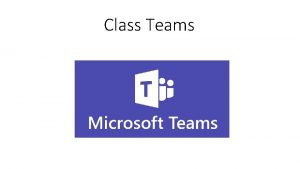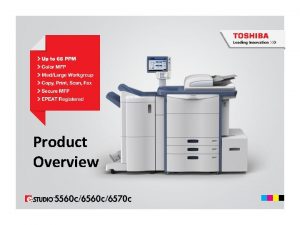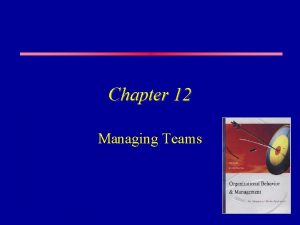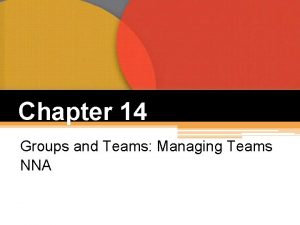Chapter 12 Managing New Product Development Teams Overview
















- Slides: 16

Chapter 12 Managing New Product Development Teams

Overview § Many organizations now use crossfunctional teams to lead and manage the NPD process. § There is considerable variation in how these teams are formed and managed. § The chapter will look at size, composition, structure, administration, and leadership of teams. 12 -2

Constructing New Product Development Teams § Team Size § May range from a few members to hundreds. § Bigger is not always better; large teams create more administrative costs and communication problems § Large teams have higher potential for social loafing. § Team Composition § Including members from multiple functions of firm ensures greater coordination between functions. § Firms around the world rely heavily on cross-functional teams for their new product development efforts. 12 -3

Constructing New Product Development Teams § Diversity in functional backgrounds increases breadth of knowledge base of team. § Other types of diversity (e. g. , organizational tenure, cultural, gender, age, etc. ) can be beneficial as well. § Provides broader base of contacts within and beyond firm. § Ensures multiple perspectives are considered. § However, diversity can also raise coordination costs. § Individuals prefer to interact with those they perceive as similar (“homophily”) § May be more difficult to reach shared understanding. § May be lower group cohesion. § Extended contact can overcome some of these challenges. 12 -4

Research Brief Boundary-Spanning Activities in NPD Teams § Ancona and Caldwell studied 45 NPD teams to identify the roles team members engage in to collect information and resources within and beyond the firm. Found three primary types: § Ambassador activities: representing team to others and protecting from interference. § Task coordination activities: coordinating team’s activities with other groups. § Scouting activities: scanning for ideas and information that might be useful to the team. § Scouting and ambassador activities more beneficial early in development cycle; task coordination activities beneficial throughout life of team. 12 -5

Structure of New Product Development Teams § One well-known typology of team structure classifies teams into four types: § Functional § Lightweight § Heavyweight § Autonomous 12 -6

Structure of New Product Development Teams § Functional Teams § Members report to functional manager § Temporary, and members may spend less than 10% of their time on project. § Typically no project manager or dedicated liaison personnel. § Little opportunity for cross-functional integration. § Likely to be appropriate for derivative projects. § Lightweight Teams § Members still report to functional manager. § Temporary, and member may spend less than 25% of their time on project. 12 -7

Structure of New Product Development Teams § Typically have a project manager and dedicated liaison personnel. § Manager is typically junior or middle management. § Likely to be appropriate for derivative projects. § Heavyweight Teams § Members are collocated with project manager. § Manager is typically senior and has significant authority to command resources and evaluate members. § Often still temporary, but core team members often dedicated full-time to project. § Likely to be appropriate for platform projects. 12 -8

Structure of New Product Development Teams § Autonomous Teams § Members collocated and dedicated full-time (and often permanently) to team. § Project manager is typically very senior manager. § Project manager is given full control over resources contributed from functional departments and has exclusive authority over evaluation and reward of members. § Autonomous teams may have own policies, procedures and reward systems that may be different from rest of firm. § Likely to be appropriate for breakthrough and major platform projects. § Can be difficult to fold back into the organization. 12 -9

The Management of New Product Development Teams § Team Leadership § Team leader is responsible for directing team’s activities, maintaining alignment with project goals, and communicating with senior management. § Team leaders impact team performance more directly than senior management or champions. § Different team types need different leader types: § Lightweight teams need junior or middle manager. § Heavyweight and autonomous teams need senior manager with high status, who are good at conflict resolution, and capable of influencing engineering, manufacturing, and marketing functions. 12 -10

The Management of New Product Development Teams § Team Administration § Many organizations now have heavyweight and autonomous teams develop a project charter and contract book. § Project charter encapsulates the project’s mission and provides measurable goals. May also describe: § § § Who is on team Length of time members will be on team Percentage of time members spend on team Team budget Reporting timeline Key success criteria 12 -11

The Management of New Product Development Teams § Contract book defines in detail the basic plan to achieve goals laid out in charter. It provides a tool for monitoring and evaluating the team’s performance. Typically provides: § Estimates of resources required § Development time schedule § Results that will be achieved § Team members sign contract book; helps to establish commitment and sense of ownership over project. 12 -12

The Management of New Product Development Teams § Managing Virtual Teams § In virtual teams, members may be a great distance from each other, but are still able to collaborate intensely via videoconferencing, groupware, email, and internet chat programs. § Enables people with special skills to be combined without disruption to their personal lives. § However, may be losses of communication due to lack of proximity and direct, frequent contact. § Requires members who are comfortable with technology, have strong interpersonal skills and work ethic, and can work independently. 12 -13

Research Brief Virtual International R&D Teams § Gassman and von Zedtwitz studied 34 technology-intensive multinationals and identified four patterns of virtual international R&D teams: 12 -14

Innovation Teams at the Walt Disney Company § In the early stages of generating and refining an idea for a movie the small incubation team includes a director, a writer, some artists, and some storyboard people. § Once approved, a movie enters production using computer-aided design (CAD) systems that apply mathematical models to simulate lifelike textures, movement, and lighting. § The process was managed by small, collocated, autonomous teams that had great discretion over their work routines. § Artists showed their ongoing work to directors and peers in “dailies, ” in order to receive regular and honest feedback. 12 -15

Innovation Teams at the Walt Disney Company Discussion Questions: 1. Why does Disney keep its development teams small? 2. What are the pros and cons of the teams being so autonomous? 3. Is Disney’s team approach mostly suited to creative projects, or would it work equally well in other kinds of industries? 12 -16
 Product life cycle kotler
Product life cycle kotler Understanding groups and managing work teams
Understanding groups and managing work teams Integrated product team ipt
Integrated product team ipt Idea generation contoh
Idea generation contoh New product development funnel
New product development funnel Food product development process
Food product development process New product development idea generation
New product development idea generation Wbs for new product development
Wbs for new product development Me too products examples food
Me too products examples food New product development procedure iso
New product development procedure iso Product planning and development
Product planning and development Embedded systems product development
Embedded systems product development Product planning and development
Product planning and development Systematic new product development
Systematic new product development Al pacino conjoint
Al pacino conjoint Overview definition
Overview definition Papercut job tickerting print management
Papercut job tickerting print management


